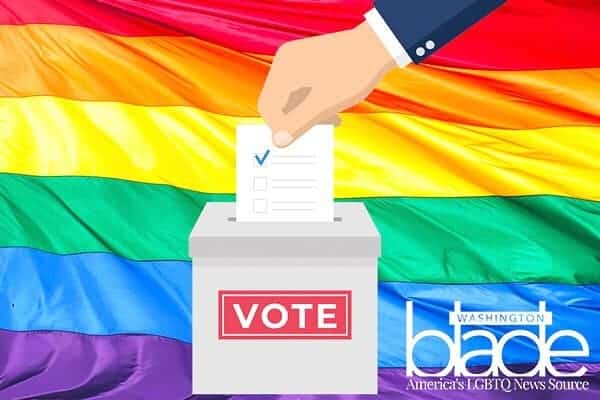Exit polling on Election Day 2018 revealed striking data about the strength LGBT voters, demonstrating they constitute a sizable 6 percent chunk of the electorate and overwhelmingly support the Democratic Party.
A trifecta of sources — exit polling from CNN, NBC News, the Wall Street Journal — consistently revealed 6 percent of the voting bloc in the congressional mid-term elections identified as LGBT. That sizable bloc represents a slight increase from years past, when an estimated 5 percent would tell a pollster they identified as LGBT.
Chad Griffin, president of the Human Rights Campaign, said in a conference call with reporters last week that exit polling has been inconsistent on including LGBT people, but his organization months ago asked media outlets to include this question to assess the size of that voting bloc.
“Once we know what the total voters are, that is likely to be around 7 million voters identified as LGBT,” Griffin said. “What’s important to note: That means 6 percent of the electorate identified to a stranger — in most cases in a swing state that they were LGBT. That is a powerful voting bloc, and that is an increase in turnout of LGBT voters from 2016.”
As the number of voters who publicly identify as LGBT has increased, so has that voting bloc’s support for the Democratic Party — at least according to exit polling from CNN and NBC News, which is based on data from the National Election Pool. Both of those outlets reported 82 percent of LGBT people voted in 2018 for a Democratic representative, while 17 percent voted Republican.
That represents an increase in Democratic support from years past. In 2016, 76 percent of LGBT-identified voters supported Hillary Clinton, but 14 percent voted for President Trump. In 2012, 77 percent of LGB-identified people voted for President Obama, while 23 percent voted for Mitt Romney.
The only other demographic group with stronger support for the Democratic Party was black voters, which in exit polls have consistently voted for Democrats over Republicans by a 9-1 margin.
Gary Gates, a former research fellow at the Williams Institute at the University of California, Los Angeles, said several factors could explain the greater number of voters identifying as LGBT as well as the increased support for the Democratic Party, including the anti-LGBT policies of the Trump administration.
“Decreased social stigma likely explains recent increases in the portion of the population identifying as LGBT,” Gates said. “Further, LGBT voters may feel particularly under threat from a Trump administration that has shown open hostility toward the transgender population and has made several attempts to minimize the visibility of LGBT populations in federal data sources. This could explain increases in LGBT voter engagement and willingness to support Democrats.”
Gates added demographic patterns among those who are coming out to exit pollers suggest younger women — who are more likely to support Democratic candidates — comprise an increasingly growing portion of people who are openly LGBT.
Daniel Pinello, a political scientist at the City University of New York’s John Jay College, said he’s unsure why there would be an increased shift toward Democrats among LGBT voters, but said the desire of federal LGBT non-discrimination protections could be a factor.
“After marriage equality, after the Obergefell decision of 2015, that’s really no longer a hot button political issue for our community,” Pinello said. “The only thing that’s really left is sexual orientation and gender [identity] discrimination in employment, housing and public accommodations, but I don’t know how much of a driving force that is politically in the same way I think marriage equality was. I doubt that most people have had those kinds of personal experiences of job discrimination of being gay or [transgender] or what have you compared to those people who have been denied marriage licenses in their lifetimes.”
The Wall Street Journal exit poll, however, demonstrates less support for the Democratic Party among LGBT people. In those results, 71 percent of LGBT voters backed Democrats, while 24 percent voted for a Republican candidate.
Transgender voters also identified separately in the Wall Street Journal exit poll, making up an estimated 1 percent of voters. Notably, those voters skewed slightly more toward the Republican Party than lesbian, gay and bisexual voters. Although a majority of transgender respondents, 58 percent, said they voted Democrat, 37 percent said they voted Republican.
Another notable point about the Wall Street Journal poll: Without the LGBT bloc, voters in the 2018 congressional mid-term election would have broken evenly between Democrats and Republicans. That indicates Democratic victories on Election Day wouldn’t have happened without LGBT support.
Gates, however, said relying on the CNN and NBC News data based on the National Election Pool is better for assessing LGBT trends as opposed to the Wall Street Journal data, which is relatively new and just started this year.
“The polling data used by the WSJ does show less, though still very strong, support for Democrats among LGBT voters, but it’s really not possible to use that to assess trends since this was the first year of that data collection methodology, which does differ from the NEP approach,” Gates said. “I will admit that the relatively strong support for Republican candidates among those identified as transgender in the new polling seems odd. But I really can’t speculate on the accuracy of that finding as data on transgender voting is very rare.”
Story courtesy of the Washington Blade.

